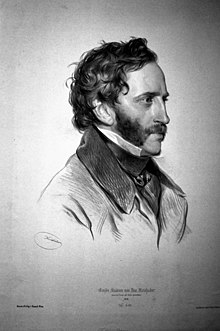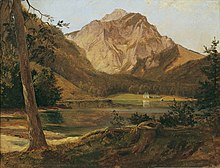Friedrich Gauermann




Friedrich August Matthias Gauermann (born September 20, 1807 in Scheuchenstein , Miesenbach municipality , Lower Austria , † July 7, 1862 in Vienna ) was an Austrian painter and graphic artist .
Life
Friedrich Gauermann was born in Miesenbach No. 47 (now Scheuchenstein 71) in Lower Austria as the son of the painter, draftsman and engraver Jakob Gauermann (1772–1843), who also taught him. The father recognized the artistic talent of his sons Carl and Friedrich at an early age and promoted it accordingly. Even in his earliest childhood it became clear that Friedrich would most likely be the more talented, the more ingenious artist, but his brother died at the age of 24. Friedrich attended the Imperial and Royal Academy of Fine Arts in Vienna from 1822 to 1827 , but mainly trained as an autodidact on extensive hikes through Styria , Salzburg and Tyrol . Gauermann went on numerous study trips, including 1824 and 1831 to the Salzkammergut , 1827 to Dresden , 1829, 1834 and 1840 to Munich , 1838 and 1843 to Venice . On 26 March 1836 he was at the Imperial Academy of Fine Arts as a landscape Mahler for Art member selected. In 1838 Gauermann married Elisabeth Kurtz. Gauermann was known to many artists in Vienna during the pre-March period ( Nestroy , Raimund ), after 1848 he became increasingly lonely and often withdrew to Miesenbach. In 1861 he was awarded membership of the Vienna Künstlerhaus . He died in the Viennese suburb of Laimgrube 24 (today Linke Wienzeile 4) and was buried in the cemetery of his birthplace Scheuchenstein.
power
Friedrich Gauermann was a very popular landscape painter of the Biedermeier period. He broke away from vedute painting , which was animated by figures, and oriented himself towards old Dutch painting . This enabled him to found a new kind of landscape naturalism in Vienna. In 1826 he exhibited his pictures, which were characterized by lighting and mood effects, for the first time. After a great exhibition success in 1830, he began to populate his forest and mountain landscapes with animals, which was to become typical of Gauermann's pictures. At the Vienna art exhibition in 1838 Gauermann was placed at the head of landscape painting . Until the 1840s he received numerous commissions for pictures of this kind from the Viennese aristocracy ( Prince Metternich , Schwarzenberg , Liechtenstein ), from which he also made outstanding contributions. As the taste of the time gradually changed after 1848, the success waned and the patrons decreased. In addition, under the influence of the Munich School , he fell into a sweet alpine manner, but this does not diminish his original importance for Austrian landscape painting of the Biedermeier period. Gauermann studied his motifs in the great outdoors. His depictions of animals stand out in Austrian painting. The outstanding art historical importance lay in his drawing and coloristic mastery.
He left 1185 oil paintings and 174 drawings . His estate was auctioned, but the proceeds ran away from his widow, who had not been able to handle money well even during his lifetime, and the money ran away from him and she ended up in the poor house.
Works (excerpt)

- The Hay Cart (Vienna, Belvedere ), 1824, oil on canvas, 21.4 × 31.5 cm
- Landscape with Scheuchenstein ruins (St. Pölten, Niederösterreichisches Landesmuseum , inv. No. 8697), 1826, oil on canvas, 35.7 × 51.2 cm
- The Altausseer See with the Dachstein (Vienna, Belvedere, Inv.No.Lg 50), around 1827, oil on canvas, 30 × 43 cm
- The Dachstein vom Plassen near Hallstatt (Vienna, Belvedere, inv.no.3221), around 1827, oil on paper laid down on canvas, 29.5 × 40.5 cm
- The front Langbathsee with the Höllengebirge (Vienna, Belvedere, inv. No. 683), 1828–30, oil on cardboard, 25.5 × 35 cm
- Landscape near Miesenbach (Vienna, Belvedere, Inv. No. 2815), around 1830, oil on canvas, 32 × 45 cm
- Am Kammersee near Aussee (Graz, Neue Galerie Graz , Inv.No. I / 1123), around 1830, oil on paper, 44.3 × 33 cm
- A vulture on a dead stag (Vienna, Belvedere, Inv.No. 3012), 1832, oil on canvas, 147 × 115 cm
- An Alpine Ship in the Storm ( Wien Museum ), 1834, oil on canvas, 94 × 73 cm
- View from Scheuchenstein to Gauermannhof with the Schneeberg in the background (Vienna, Belvedere, inv. No. 3290), around 1835, oil on paper laid down on canvas, 28 × 40.5 cm
- Livestock market in Maria Plain near Salzburg (St. Pölten, Niederösterreichisches Landesmuseum, inv. No. 7197), 1837, oil on canvas, 104 × 145.5 cm
- The Return of the Hunters (Wien Museum), 1844, oil on canvas, 65 × 50 cm
- Seeauer Alpenhütte im Regen (St. Pölten, Niederösterreichisches Landesmuseum, inv. No. 3611), around 1850, oil on wood, 68.4 × 88.8 cm
- A ship train on the Danube (Wien Museum), 1860, oil on canvas, 60 × 48 cm
Honors
Appreciations and reception
- The Gauermann Museum is located in Scheuchenstein (municipality of Miesenbach) today , in which, in addition to documentation on his life and paintings by the artist, special exhibitions are also held on an ongoing basis.
- In Vienna's inner city , Gauermanngasse was named after him and his father Jakob Gauermann in 1870 .
- In 1962, on the occasion of the 100th year of his death, the Lower Austrian State Exhibition took place in Gutenstein and Miesenbach.
- In 2007 the Austrian Post issued a special postage stamp on the occasion of Friedrich Gauermann's 200th birthday.
literature
- Constantin von Wurzbach : Gauermann, Friedrich . In: Biographisches Lexikon des Kaiserthums Oesterreich . 5th part. Typogr.-literar.-artist publishing house. Establishment (L. C. Zamarski & C. Dittmarsch.), Vienna 1859, pp. 104-107 ( digitized version ).
- Karl Weiß: Gauermann, Friedrich . In: Allgemeine Deutsche Biographie (ADB). Volume 8, Duncker & Humblot, Leipzig 1878, pp. 420-422.
- Rupert Feuchtmüller: Gauermann, Friedrich. In: New German Biography (NDB). Volume 6, Duncker & Humblot, Berlin 1964, ISBN 3-428-00187-7 , p. 96 f. ( Digitized version ).
- Rupert Feuchtmüller: "Friedrich Gauermann 1807–1862". Rosenheimer Verlagshaus, Rosenheim, 1987, ISBN 3-475-52532-1
- Gauermann Friedrich. In: Austrian Biographical Lexicon 1815–1950 (ÖBL). Volume 1, Verlag der Österreichischen Akademie der Wissenschaften, Vienna 1957, p. 411.
Web links
- Literature by and about Friedrich Gauermann in the catalog of the German National Library
- Entry on Friedrich Gauermann in the Austria Forum (in the AEIOU Austria Lexicon )
- Works by Friedrich Gauermann in: Digitales Belvedere
- Entry on Friedrich Gauermann in the database of the state's memory for the history of the state of Lower Austria ( Museum Niederösterreich )
- Gauermann Museum in Scheuchenstein
Individual evidence
- ↑ Vienna. (...) art members. In: Wiener Zeitung , April 6, 1836, p. 441, top center. (Online at ANNO ). .
-
↑ Joseph Preleuthner: Vienna Art Exhibition in 1838. In: Wiener Zeitschrift für Kunst, Literatur, Theater und Mode , No. 47/1838, April 19, 1838, pp. 369–372. (Online at ANNO ). ;
Joseph Preleuthner: Vienna Art Exhibition in 1838 (continued). In: Wiener Zeitschrift für Kunst, Literatur, Theater und Mode , No. 48/1838, April 21, 1838, pp. 377–380. (Online at ANNO ). .
| personal data | |
|---|---|
| SURNAME | Gauermann, Friedrich |
| ALTERNATIVE NAMES | Gauermann, Friedrich August Matthias (full name) |
| BRIEF DESCRIPTION | Austrian painter and graphic artist |
| DATE OF BIRTH | September 20, 1807 |
| PLACE OF BIRTH | Scheuchenstein , Miesenbach municipality , Lower Austria |
| DATE OF DEATH | July 7, 1862 |
| Place of death | Vienna |